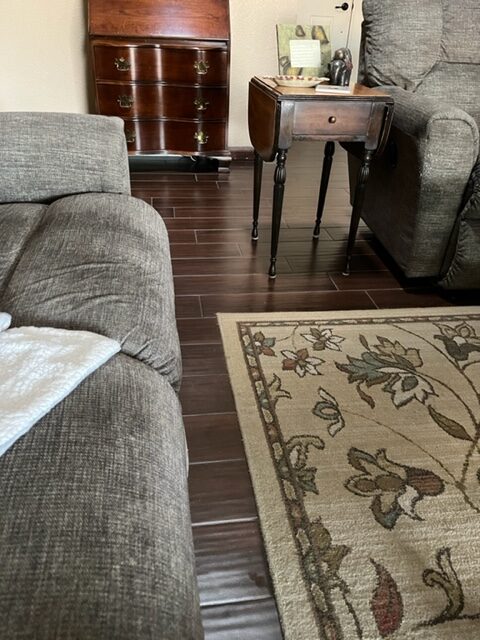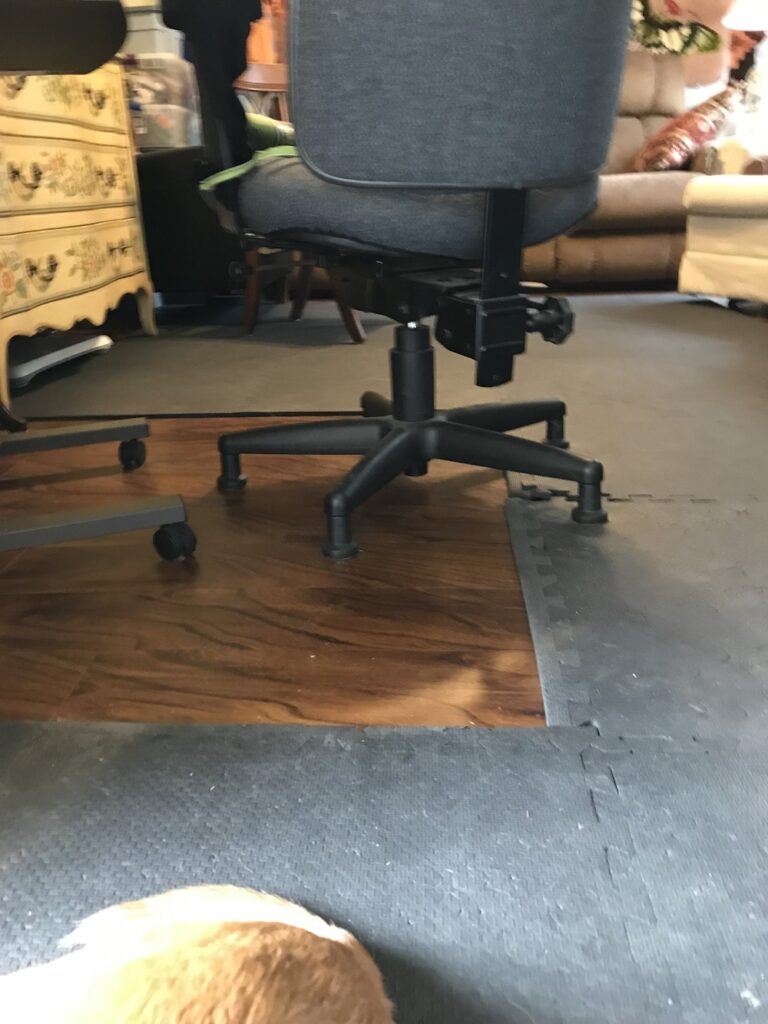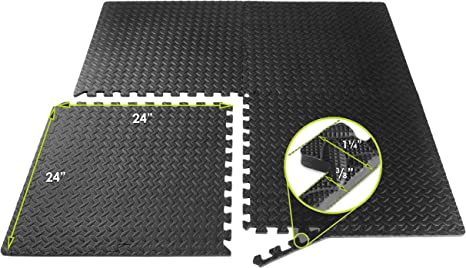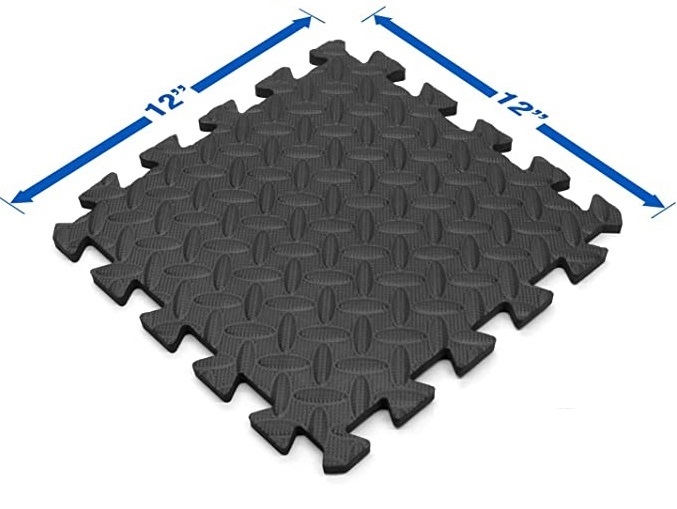2022/12/22 (10 minute read)
Pad Your Landing Spot
Ever considered installing EVA Foam floor pads in your home?
What price beauty? Our friend Barbara has PN. Recently, she fell. Her body hit the beautiful tile floors that she had just used to make her house look so nice. See the first photo. The injuries took time to heal. Fortunately, they did heal. This time. Some floor pads might have helped.


Inability to recover from a fall is a leading cause of death in older adults.
If we have normal PN, eventually our balance fades and we start falling. If we get old (most of us will, with PN or not) we often find our balance an issue (though exercise can help).
When we fall, we head down, not up. Since the direction is down, perhaps we should take a careful look down. Instead of focusing on the images from “House Beautiful” and “Good Housekeeping,” perhaps a bit of padding on the floor can help us stay in that home. And savor the other things we see when we eventually look up from the floor we just landed on.
Do an internet search for “interlocking floor pads.” Twenty years ago, for reasons unrelated to PN, I did that. We also put in nice looking floors. As my PN and lack of balance progressed, I gradually covered our floors with those floor pads. At first it was simply to protect the floor from tracked-in grit, instead of using risky throw rugs. But safety became the key factor. The second photo above shows some of them in my house. The dog in the foreground is highly recommended but optional.
The pads have paid off. By my rough count, I have fallen hard in the house about six times. Six times I have gotten up, a bit sore and bruised (and embarrassed), but fully functional.
At first, we kept some area rugs. But transitions between rugs and pads became threatening. And the floor pads have more traction than the rugs. So eventually the area rugs went away too.
Some Technical Details About Floor Pads
The pads have interlocking edges. Edge pieces are provided in the packages to create a smooth edge. Most vendors ads do not accurately describe the size of the actual pad (without its edge pieces). For instance, the next image (from Prosourcefit) is ambiguous about the pad size. It suggests 2 feet, but is that the pad itself? Or the pad with one edge? Or with two edge pieces?
Unfortunately, none of the big online retailers (Amazon, Walmart, Costco, etc.) have acknowledged this problem and required their vendors to advertise the size of the pads in a way that makes it possible for the consumer to easily avoid ambiguity. The next image (from Yes4All) is wonderfully unambiguous (though for a smaller 1-foot pad). But it does not specify the width of the edge pieces. Close, but no cigar.


Pros for Floor Pads
- Made of EVA foam (Ethylene-Vinyl Acetate) that does not absorb water, oil or most liquids. They are easy to clean.
- A non-skid surface (even when damp).
- Easy to lay.
- Easy to cut with a big pair of scissors.
- Durable to foot (and paw) traffic.
- Good for a home exercise area.
- Available in colors (for your inner child?). Some have a wood grain look, but I must wonder about the durability of those. I used some “carpet topped” ones near dog entry ways but found them hard to keep clean.
- If you find yours become worn and unattractive and want to replace them, they will remain functional so can be given away to services that “free cycle” things.
Cons for Floor Pads
- The joints between pads are not sealed and will allow water or fluids to pass through. If laid on wood floors or a lot of water is spilled, the pads should be lifted to dry any spills.
- Grit will eventually sift between the pad joints, so you may want to occasionally lift them up and clean the floors and the undersides of the pads. That is probably more important for wood floors.
- In areas where spills are a problem (such as a bathroom), it is possible to glue the edges together to prevent liquids passing through. I have used standard liquid Gorilla glue. But applying the glue is a big job. And the resulting joints are rigid and a bit painful to walk on with bare feet. I put a layer of plastic film under the pad set in case the glued joints were not perfectly watertight.
Some Floor Pad Details and Cautions
- I use pads that are 3/8″ thick. Thicker pads are available (1/2″, 3/4″ and 1″). The thicker pads would provide more cushioning in a fall, but I wonder if the thicker pads would have too much “give” and jeopardize a person’s balance. I have not tried them. My 3/8″ pads have been sufficient protection so far.
- While a set of several pads interlocked together will resist sliding on a smooth surface (like tile or wood), a single long row of pads is not heavy enough to stay in place. You need to lay enough pads so their combined interlocking, weight and friction (or placement against a wall or furniture) is enough to keep the pads from sliding or shifting out of place. To minimize movement of the pads, I eventually decided to cut some pads to custom fit against hallway walls, furniture and around stairs.
- A typical “24 square feet” package will contain 6 pads, 4 “corner” edge pieces and 7 “straight” edge pieces. That is enough edge pieces to surround the entire set if they are laid in a set of two rows of 3 pads each, with one straight edge piece left over. Such an arrangement, with the edges attached, will cover the advertised “24 square feet.” But see the cautions below if you want to use them in a different manner (as will normally be the case). In general, you may need to buy a few more such packages than simply taking your raw square footage and dividing by 24.
- The standard 6-pad package may not provide enough edge pieces for some layouts (such as a hallway with 6 pads end to end). Or, for large open areas using many packages, you may end up with many extra edge pieces. Some vendors may offer packages with just pads or just edges. Note that you can always trim a “corner” edge piece to serve as an “straight” edge piece.
- While the pads are quite durable, the surfaces will eventually wear with foot traffic, and you may want to replace some. Or you may want to lay pads in an additional area (as I did many times). That can be a challenge since there is no “standard size” for pad width without the edge pieces. Some brands have wider edge pieces and, as a result, smaller pads. And, over time, the same manufacturer may change those widths. You might buy some additional pads and find, when they arrive, that the new ones do not quite interlock with the old ones because the new pads are slightly wider or narrower than the old ones. Also, while most interlock tab patterns LOOK to be the same design, the size of the little tabs that interlock vary too. Most packages are advertised as being 24 square feet square in a package. But that is only true when the 6 pads are interlocked in 2 rows of 3 pads each with their edge pieces attached on all four sides of the set. Since, as mentioned above, vendor ads may not specify the exact, unambiguous size, before you buy additional pads carefully measure the pads you have WITHOUT THE EDGE. And measure the interlock tabs. Then ask the vendors to tell you exactly how wide their pads are without the edges and how wide and deep the interlock tabs are. Try to find a product that is close to what you already have. Because the pads are foam, there is some give and the match need not be exact. Buy them from an online service that will allow you to return them if they are not as you were told. And when they arrive measure the new ones with a ruler to confirm the measurements. (This is the voice of painful experience speaking.)
- Pads used to be available in a rather odd edge pattern that has one interlock tab that is different than the others. If they are still available, avoid them since they will not interlock with most new ones.
One further note: In the photo from my living room is my old beat-up office chair. It has had its wheels removed. I replaced them with simple pads. The result is a comfortable chair that swivels but is secure when I get in or out of it.

I have heated stained concrete floors, the only source of heat beyond the passive solar from a wall of windows. Is there a heating specialist who can advise me on how adding padding would affect the heating system?
I suspect the heat will easily pass through the pads, as they would through a carpet. For a few dollars you can get a package and give it a try. But you might try one of the builder advice sites to see if there is someone who can comment. There must be lots of family with children who want to put down pads for a play area.